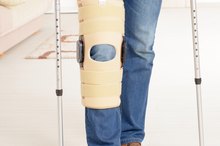Complications After Partial Knee Replacement
Partial or unicompartmental knee replacement is a surgical procedure used to increase knee function and alleviate chronic knee pain in affected people 12. During this procedure, a surgeon specifically replaces the damaged portions of the knee, while keeping all healthy bone and cartilage intact. In contrast, total knee replacement surgery involves replacing the entire knee joint. Patients should talk with a doctor about the complications after partial knee replacement before undergoing this type of surgery.
If you are experiencing serious medical symptoms, seek emergency treatment immediately.
Deep Vein Thrombosis
The most common complication following partial knee replacement surgery is the formation of blood clots in the legs, according to the American Association of Orthopaedic Surgeons 2. This complication, which is also referred to as deep vein thrombosis, can affect the way blood normally flows through the leg. Patients can experience swelling, bruising or pain in the affected leg, which can make it difficult to place weight on the leg. A blood clot that detaches from the inside of a leg vein may travel through the bloodstream to a patient's lungs. This life-threatening complication is called pulmonary embolus, and affected patients can experience severe breathing difficulties or heart rate irregularities. If these complications arise after surgery, affected patients should seek immediate medication intervention.
- The most common complication following partial knee replacement surgery is the formation of blood clots in the legs, according to the American Association of Orthopaedic Surgeons 2.
- This life-threatening complication is called pulmonary embolus, and affected patients can experience severe breathing difficulties or heart rate irregularities.
Nerve or Blood Vessel Damage
Most Common Side Effects After Hip Replacement Surgery
Learn More
The nerves and blood vessels that surround the knee joint can sustain damage during partial knee replacement surgery. Nerve damage can lead to sensations of tingling, numbness or burning within the affected leg after surgery. As the surgical site begins to heal, these symptoms of nerve damage typically subside. Blood vessel trauma, if it occurs, is typically detected and immediately repaired by a surgeon during partial knee replacement surgery. Patients who experience persistent tingling, numbness or discomfort should receive further evaluation and care from a doctor.
- The nerves and blood vessels that surround the knee joint can sustain damage during partial knee replacement surgery.
- Nerve damage can lead to sensations of tingling, numbness or burning within the affected leg after surgery.
Persistent Pain
Partial knee replacement surgery is not always a successful method of pain relief. In fact, certain patients can continue to experience chronic knee pain symptoms after surgery, MedlinePlus reports. Knee pain may be constant or can occur intermittently after increased physical activity. Certain patients can also experience mild to moderate pain while kneeling on the healed knee. Chronic or severe pain complications should be promptly discussed with a physician if they arise.
- Partial knee replacement surgery is not always a successful method of pain relief.
Infection
Complications From Arthroscopic Knee Surgery
Learn More
An infection of the knee joint or surgical site can occur as a complication of this surgical procedure. Affected patients may notice that the knee joint feels warm or tender to the touch. Knee pain symptoms may progressively increase in severity as a result of an infection. Certain patients may also experience fluid accumulation around the newly placed knee implant. An infection of the surgical incision site can cause inflammation, redness, tenderness or unusual drainage. Patients who develop infection complications typically require treatment with an antibiotic to resolve symptoms.
- An infection of the knee joint or surgical site can occur as a complication of this surgical procedure.
- Certain patients may also experience fluid accumulation around the newly placed knee implant.
Implant Problems
Over time, the partial knee implant can loosen and fall away from the bone, the University of Washington School of Medicine warns. If this occurs, additional surgery may be necessary to replace the implant with a new one.
Related Articles
References
- MedlinePlus: Unicompartmental Knee Arthroplasty
- American Academy of Orthopaedic Surgeons: Unicompartmental Knee Replacement
- Campi S, Tibrewal S, Cuthbert R, Tibrewal SB. Unicompartmental knee replacement - Current perspectives. J Clin Orthop Trauma. 2018;9(1):17-23. doi:10.1016/j.jcot.2017.11.013
- Cleveland Clinic. Partial Knee Replacement. Updated July 10, 2016.
- Hospital for Special Surgery. Partial Knee Replacement: A Treatment Option in Unicompartmental Knee Arthritis. Published February 13, 2013.
Writer Bio
Rae Uddin has worked as a freelance writer and editor since 2004. She specializes in scientific journalism and medical and technical writing. Her work has appeared in various online publications. Uddin earned her Master of Science in integrated biomedical sciences with an emphasis in molecular and cellular biochemistry from the University of Kentucky College of Medicine.








